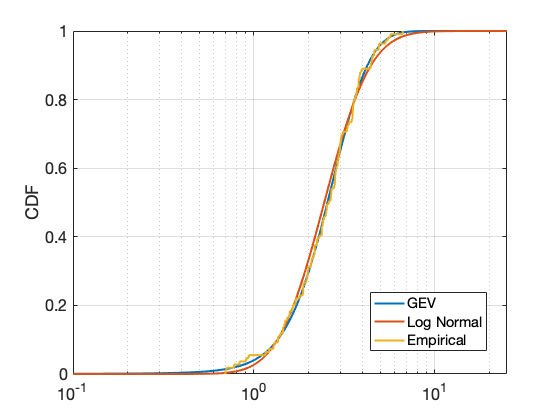I have some time series data spanning 30+ years and I am trying to do some extreme value analysis. Major disclaimer: I am not a statistician so I feel that I am wading into waters beyond my area of expertise. Just trying to learn here.
I am using MATLAB to get lognormal and generalized extreme value (GEV) fits for block maxima time series. Essentially, I divide the time series up into a series of blocks (e.g. 10 days), and then compute the maximum value for each of those blocks. Then I fit different distributions to the list of block maxima.
However, I find that the choice of block length has a significant impact on the fits. If I choose a 1-day or 5-day block to find the maxima value, then the GEV performs very poorly (especially towards the extremes). Below is a figure of CDFs of GEV and lognormal fits to the empirical CDF using 1-day block maxima:
If I pick a much longer interval (e.g. 100 days), then the GEV and lognormal fits performs much better (at least visually). Below is a figure using a 100-day block maxima:
I have three questions:
(1) Why do the smaller block lengths not result in good fits? What is the underlying reason?
(2) How do you pick the length of your blocks to perform the extreme value analysis? Is it just arbitrary?
(3) If I want to estimate the chance of exceeding some threshold in a given day (or month, or year), does this have any relation to the block length? For example, do I need to pick a 1-day block length in order to estimate the chance of exceeding a threshold in a given day? Or can I use a longer block length and then scale things accordingly?
Any info is appreciated.


